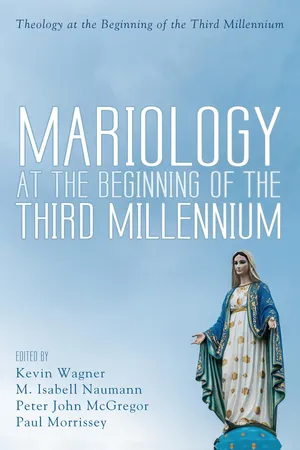
- 268 pages
- English
- ePUB (mobile friendly)
- Available on iOS & Android
About this book
Since the Second Vatican Council the place of Mary in theology and generally in the life of the Church has been at times muted. This is perhaps understandable given the debates concerning Mary's "place" in the documents of Vatican II. In an ecumenical age, it was argued, the church needed a less triumphalist Mariology and piety with a greater focus on Mary as model disciple. In certain respects this has led to a dichotomy between the continued Marian piety of many faithful (and, truth be told, the piety of the post-conciliar popes) and a theological timidity concerning Mary.This collection of chapters seeks to address the current situation of Mariology. Taken as a whole these chapters represent a welcome call for renewal and reawakening in Mariology. The collection is also delightfully eclectic, both in terms of topics covered and in terms of the denominational and academic backgrounds of the authors.
Frequently asked questions
- Essential is ideal for learners and professionals who enjoy exploring a wide range of subjects. Access the Essential Library with 800,000+ trusted titles and best-sellers across business, personal growth, and the humanities. Includes unlimited reading time and Standard Read Aloud voice.
- Complete: Perfect for advanced learners and researchers needing full, unrestricted access. Unlock 1.4M+ books across hundreds of subjects, including academic and specialized titles. The Complete Plan also includes advanced features like Premium Read Aloud and Research Assistant.
Please note we cannot support devices running on iOS 13 and Android 7 or earlier. Learn more about using the app.
Information
Mariology at the Beginning of the Third Millennium
Table of contents
- Title Page
- Contributors
- Preface
- Chapter 1: Mariology at the Beginning of the Third Millennium
- Chapter 2: The Virgin Mary in Ancient Christian Tradition
- Chapter 3: Theotokoupoleis
- Chapter 4: Mariology of John Paul II: An Overview
- Chapter 5: Marian Arks Cut Adrift
- Chapter 6: How Is Mary a Seat of Wisdom?
- Chapter 7: Revisiting the Marian Dimension of Ignatian Spirituality
- Chapter 8: Mary as Priest, Prophet, and King
- Chapter 9: Luke 1:26–38 as a Model of Dialogue
- Chapter 10: Marian Epistemology
- Chapter 11: Mary the Temple of Scripture
- Chapter 12: Towards a Patristic Theology of Barrenness
- Chapter 13: Lex orandi, lex credenda. Dulia, Hyperdulia, et Latria